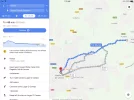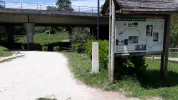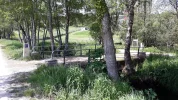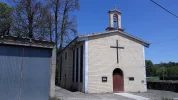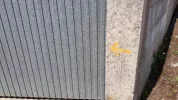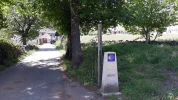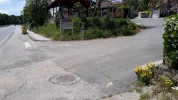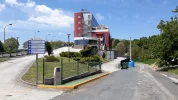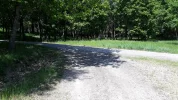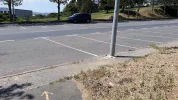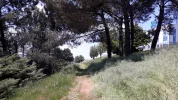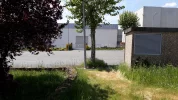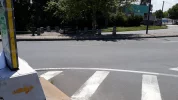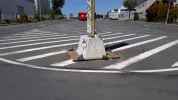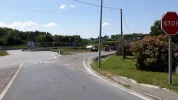Bad Pilgrim
Veteran Member
- Time of past OR future Camino
- Yes
Hi everyone,
I promised to write this for so long now… Here it comes!
Summary: I walked the Invierno this year (summer 2018) between July 19 and July 27. That makes 9 stages which is perfect for me! But as Laurie’s Invierno guide suggests, there are several ways to change this if you want to make more or fewer stages. I stayed in the same towns as in 2015, when I walked the Invierno for the first time. I was eager to see how much had changed on this route since three years…!
I am posting this mainly to point out things that could go into the next version of the Camino de Invierno guide! Just tag along and feel free to comment!
July 18: Arrival to Ponferrada by bus
I had previously finished my Camino Mozárabe (from Almería) in Mérida. I decided to take the bus between Mérida and Ponferrada to start the Camino de Invierno for a second time. The bus departed from Mérida about 01:30 a.m. (gasp!). Needless to say, I was the only traveler waiting for the bus at the dark, spooky backyard of the Mérida bus station in the middle of the night.
July 19: Beginning from Ponferrada: I had been to Ponferrada many times before and I am always keen on checking out new albergues or other places to stay. So, this time I opted for the private albergue Guiana. It is very easy to find. Whether you come walking from the bus station in Ponferrada or from the Camino Francés, you will certainly stumble upon it. It is placed at about an equal distance between the medieval castle and the municipal albergue on the Camino Francés. Very clean and modern, looking as if it was built yesterday. A breakfast as if it was a buffé in a hotel (although centered on the sweet stuff: bread, jam, fruit, berries, cereals… and almost nothing salty. The staff pointed this out to me as some pilgrims prefer salty things for breakfast). Breakfast +5 euros, washing machine +5 euros. I don’t remember the price for the actual stay, but since it is a private albergue I guess it was some 10-15 euros. What more can I say? Very friendly staff as well. I am definitely coming back! :OD
About Priaranza del Bierzo: leaving the village, there is a path leading upwards among the woods/bushes. I missed this path, although I had already been here once before! I took a picture of the spot, as I was bewildered by the facts that there was no waymark there and that I didn’t make that mistake last time around!? Only when I was examining the photo later that day, I saw the corner of the mojón, hidden behind the bushes. So a warning here in summer: if the mojón is overgrown, you will most likely continue on the larger road, missing the dirt path that goes upwards among the hills.
About Villavieja: There are many wooden signs about an albergue before entering Villavieja so apparently they have one up and running now. I didn’t see it from where I walked through the village so I don’t know where it is located. Neither was there any sign of the infamous mastiff that scares pilgrims en masse.
I might add right away: this is the Camino of the Doggies. There are dogs everywhere, especially on the first stage (until Las Médulas), often unchained. I was going to count them this time, but I gave up when I got to about 15 already in the morning. But none of them was aggressive. They seemed very well educated! Some of them approached me to greet me or to sniff at my legs; calmly, without any snarls or other aggressive behavior. There were no problems at all. (Although on subsequent stages I would meet some of the more aggressive specimens. But it is all just for showing off: they never even touched me.)
About Puente de Domingo Florez: My end for the day. I stayed in Hostal La Torre, as I did in 2015. The easiest way to get there is to turn right, just as you come down from the hills. Follow the road, emerge on the N-536 and after a few minutes the Hostal La Torre appears on your left. I write this because, in 2015, I lost a lot of time running around in town looking for the hostal… Perhaps this could go into the updated guide as well.
I payed 18 euros, which is reported as being an exception in the guide. Nice surprise! Important: the phone number in the guide 987 460 589 to Hostal La Torre did not work (for me) but the other number listed in the guide did. When leaving the next day, the guide also says there may be no marking at the Día supermarket but there is a mojón!
Well that’s all for the first day. As you can see I focus on things that could be of interest for the guide, and not so much on experiences, weather, fortunes-misfortunes and so on… I hope you can make something out of it. Of course it is an extremely beautiful Camino!! I will get back to you with my notes of the second day (it will be much shorter than this post).
Byyyyye!
/Bad Pilgrim
I promised to write this for so long now… Here it comes!
Summary: I walked the Invierno this year (summer 2018) between July 19 and July 27. That makes 9 stages which is perfect for me! But as Laurie’s Invierno guide suggests, there are several ways to change this if you want to make more or fewer stages. I stayed in the same towns as in 2015, when I walked the Invierno for the first time. I was eager to see how much had changed on this route since three years…!
I am posting this mainly to point out things that could go into the next version of the Camino de Invierno guide! Just tag along and feel free to comment!
July 18: Arrival to Ponferrada by bus
I had previously finished my Camino Mozárabe (from Almería) in Mérida. I decided to take the bus between Mérida and Ponferrada to start the Camino de Invierno for a second time. The bus departed from Mérida about 01:30 a.m. (gasp!). Needless to say, I was the only traveler waiting for the bus at the dark, spooky backyard of the Mérida bus station in the middle of the night.
July 19: Beginning from Ponferrada: I had been to Ponferrada many times before and I am always keen on checking out new albergues or other places to stay. So, this time I opted for the private albergue Guiana. It is very easy to find. Whether you come walking from the bus station in Ponferrada or from the Camino Francés, you will certainly stumble upon it. It is placed at about an equal distance between the medieval castle and the municipal albergue on the Camino Francés. Very clean and modern, looking as if it was built yesterday. A breakfast as if it was a buffé in a hotel (although centered on the sweet stuff: bread, jam, fruit, berries, cereals… and almost nothing salty. The staff pointed this out to me as some pilgrims prefer salty things for breakfast). Breakfast +5 euros, washing machine +5 euros. I don’t remember the price for the actual stay, but since it is a private albergue I guess it was some 10-15 euros. What more can I say? Very friendly staff as well. I am definitely coming back! :OD
About Priaranza del Bierzo: leaving the village, there is a path leading upwards among the woods/bushes. I missed this path, although I had already been here once before! I took a picture of the spot, as I was bewildered by the facts that there was no waymark there and that I didn’t make that mistake last time around!? Only when I was examining the photo later that day, I saw the corner of the mojón, hidden behind the bushes. So a warning here in summer: if the mojón is overgrown, you will most likely continue on the larger road, missing the dirt path that goes upwards among the hills.
About Villavieja: There are many wooden signs about an albergue before entering Villavieja so apparently they have one up and running now. I didn’t see it from where I walked through the village so I don’t know where it is located. Neither was there any sign of the infamous mastiff that scares pilgrims en masse.
I might add right away: this is the Camino of the Doggies. There are dogs everywhere, especially on the first stage (until Las Médulas), often unchained. I was going to count them this time, but I gave up when I got to about 15 already in the morning. But none of them was aggressive. They seemed very well educated! Some of them approached me to greet me or to sniff at my legs; calmly, without any snarls or other aggressive behavior. There were no problems at all. (Although on subsequent stages I would meet some of the more aggressive specimens. But it is all just for showing off: they never even touched me.)
About Puente de Domingo Florez: My end for the day. I stayed in Hostal La Torre, as I did in 2015. The easiest way to get there is to turn right, just as you come down from the hills. Follow the road, emerge on the N-536 and after a few minutes the Hostal La Torre appears on your left. I write this because, in 2015, I lost a lot of time running around in town looking for the hostal… Perhaps this could go into the updated guide as well.
I payed 18 euros, which is reported as being an exception in the guide. Nice surprise! Important: the phone number in the guide 987 460 589 to Hostal La Torre did not work (for me) but the other number listed in the guide did. When leaving the next day, the guide also says there may be no marking at the Día supermarket but there is a mojón!
Well that’s all for the first day. As you can see I focus on things that could be of interest for the guide, and not so much on experiences, weather, fortunes-misfortunes and so on… I hope you can make something out of it. Of course it is an extremely beautiful Camino!! I will get back to you with my notes of the second day (it will be much shorter than this post).
Byyyyye!
/Bad Pilgrim
Last edited:











